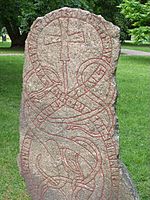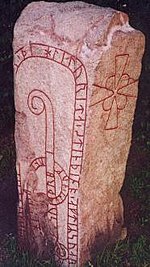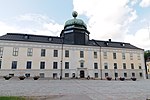Uppsala Cathedral (Swedish: Uppsala domkyrka) is a cathedral located between the University Hall of Uppsala University and the Fyris river in the centre of Uppsala, Sweden. A church of the Church of Sweden, the national church, in the Lutheran tradition, Uppsala Cathedral is the seat of the Archbishop of Uppsala, the primate of Sweden. It is also the burial site of King Eric IX (c. 1120–1160, reigned 1156–1160), who became the patron saint of the nation, and it was the traditional location for the coronation of new Kings of Sweden.
The current archbishop is Martin Modéus and the current bishop is Karin Johannesson.
The cathedral dates to the late 13th century and, at a height of 118.7 metres (389 ft), it is the tallest church in the Nordic countries. Originally built under Roman Catholicism, it was used for coronations of Swedish monarchs for a lengthy period following the Protestant Reformation. Several of its chapels were converted to house the tombs of Swedish monarchs, including Gustav Vasa and John III. Carl Linnaeus, Olaus Rudbeck, Emanuel Swedenborg, and several archbishops are also buried here.
The church was designed in the French Gothic style by French architects including Étienne de Bonneuil. It is in the form of a cross formed by the nave and transept. Most of the structure was built between 1272 and 1420 but the western end was completed only in the middle of the 15th century. Twin towers were built shortly afterwards on the west end of the church. High spires were added later, but after a fire in 1702, they were adorned with low helms by Carl Hårleman in 1735. They were completely redesigned by Helgo Zetterwall who undertook substantial changes to the building in the 1880s. The cathedral's principal construction material is brick but the pillars and many details are of Gotland limestone.
The vaults were all built according to the original 13th-century plan although some of them were erected as late as around 1440. In addition to the artwork in the funeral chapels, several of the church's older furnishings can be seen in the Treasury Museum. In 1702, many features were destroyed in a major fire. During the renovation work carried out in the 1970s, many of the medieval frescoes which had been whitewashed over after the Reformation were uncovered and restored.












